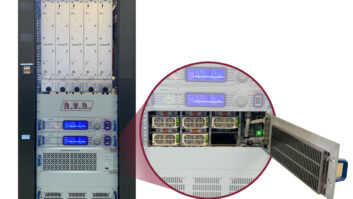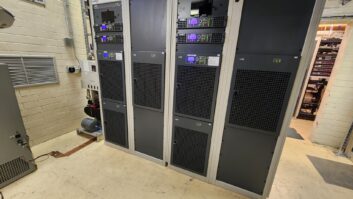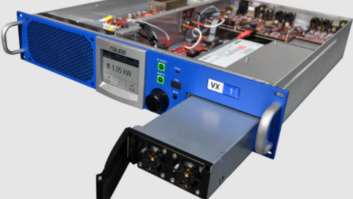Radio World contacted representatives of several leading transmitter manufacturers and asked questions on the state of the industry and where it’s going.
How strong do you believe is the long-term health of the over-the-air radio transmission manufacturing sector? Why?
Our respondents were united in their belief that the transmitter manufacturing industry has a strong future. Digital broadcasting is seen as the leading driver for future growth. This was especially true for international companies. But there was concern over a lack of direction from broadcast authorities when it comes to exactly what digital path will be taken and when.
Tim Anderson Tim Anderson, GatesAir: There has been consolidation among the traditional domestic transmission equipment manufacturers and increased competition from European and Asian manufacturers. We believe that the over-the-air radio transmission manufacturing sector remains strong both domestically and internationally. We see significant opportunity with new licensees in Latin America, the U.S. and India. Significant replacement business in parts of Europe where the digital transition has been delayed and operators are eager to leverage lowest total cost of ownership in large network operations is solid and growing. At the same time DAB is continuing to roll out all over Europe, providing solid business for our Band III transmission solutions. In the U.S., the demand for elevated HD Radio power and improved efficiency is driving considerable upgrade business.

Tony Peterle, WorldCast Systems/Ecreso:I see the broadcast sector remaining very strong, for a long time to come. Despite the fragmentation of the audience and the emergence of IP streaming services for audio and video, there is still no substitute for the true one-to-many topology of broadcast. It’s still far and away the most efficient method of delivering content to a large number of users. The transmission manufacturing sector may continue to contract, though — the market is demanding ever-lower costs simultaneously with ever-increasing longevity. New broadcast formats and features will breathe some additional revenue into the industry.
Jochen Huber, Transradio: The health of the over-the-air radio transmission manufacturing sector will depend more or less on the ongoing standardization of digital broadcasting in general. At this time there are a lot of digital standards in the field and many broadcasters are uncertain on how to invest. DAB, DAB+, ISDBT, DRM, DRM+, HD Radio and so on … Too many standards and no guidance from local governments nor from the EU or other organizations. Therefore, some broadcasters are holding back on new investment and running existing transmitters far beyond their predicted lifetime.
Scott Incz, BW Broadcast: It very much depends on the manufacturing company’s international reach and customer base. Although some countries are moving towards digital radio, many others are still happy to deliver analog FM for a considerable period of time. If you are asking where I think it’s heading: IP delivery all the way to the listener. Ironically, such a delivery vehicle could even allow developing countries to leapfrog developed nations as they embrace modern mobile technologies that will come with fast IP delivery as standard. I have said for years that I think wireless IP radio, cell network or otherwise, will make DAB, HD, DRM and other competing technologies a thing of the past.
What is the most notable trend in transmitter design right now?
This question produced no jetpack/helicopters-in-every-driveway-type of future technology answer. It did produce a blending of business practice, operational efficiency and advancement of current newborn technologies. For newish technologies, digital control and connectivity predominate.
Matthias Stoll Matthias Stoll, Ampegon: Product reliability and long-term sustainability of the product are the key success factors for products on the market today. Advances in the silicon industry and application of its parts are driving the improvement process of products. New customer demands and reduced complexity are also driving factors for new technology. State-of-the-art equipment has to be designed and operated with intuitive concepts for the operator and controller. The combination of the operator and the controller in one person requires new approaches for control and connectivity in a modern digital broadcast environment.

Tim Bealor Tim Bealor and Broadcast Electronics: Broadcast technologies are rapidly getting smaller and more efficient. The result is that manufacturers can integrate more devices and features at the transmitter level. That means broadcasters can do more with less, quickly adapt to new or different digital standards and take advantage of higher power levels.

Gianluca Busi, Elenos: We are looking at the overall energy efficiency, the compactness, the scalability and the reliability of our products. In 2007, Elenos introduced one of the first, if not the first, high power transmitter with an overall efficiency better than 70 percent, and in a highly compact form — 1.25 kW/rack unit. Energy efficiency is the first big goal that allows the broadcaster to immediately realize a real, large-scale economy in terms of money spent in energy. The effort was focused, first of all, in the design of the RF power amplifiers (first time working in F Class) and in the power supplies.
Tim Anderson, GatesAir: The most notable trend is for higher power density, smaller footprints, higher efficiency and lower maintenance systems designed to deliver lower overall lower total cost of ownership over the life of the transmission system. The consolidation of transmission facilities where floor space is at a premium is driving a trend toward multiple transmitters in a single rack and a proliferation of N+1 architectures.
John Whyte, Nautel: I think clearly it has to be the race to add intelligence and control in the transmitter and put that power to work for the broadcaster. The end result is to make transmitters more capable, easier to service, faster to diagnose and even begin to act as the hub of control for the remote site.
We continue to put a lot of work and innovation into this area. We see this as a response to the increasing demands being placed on broadcast engineers. Broadcast engineers continually tell us about the challenges they face in having to support more and more sites and more equipment. They need more and faster information about what is going on in the transmitter and sometimes look to the manufacturer for additional support.
Jochen Huber, Transradio: In the high-power market there is no trend, except that all broadcasters ask for DRM capability even when they don’t plan to use it. In the FM and the digital TV range the trend is for higher efficiencies, though these efficiencies are far below the efficiency reachable with modern AM transmitters.
How far can manufacturers push the limits of overall energy efficiency? Is there room for improved transmitter quality — new materials, new components, new designs, extended life?
There was universal agreement that AM and FM transmitter efficiency had neared its natural limit and any great leap forward was not likely. Improvements when they come will come in small increments. There were suggestions for tweaks.
John Whyte John Whyte, Nautel: We spend a lot of time asking that question. We’ve pushed AM technology to 90 percent efficiency, which is astounding. On the FM side, as long as a manufacturer is designing with the latest power supply and FET technologies, they should be able to offer efficiencies that hit the low-to-mid 70s. That means the easy gains have been achieved, especially for AM, and efficiency improvements going forward will be incremental. Our engineers will continue to push the boundaries of what is possible.

The one exciting opportunity for efficiency is in digital transmission. Nautel recently introduced technology called Spectrum/Efficiency Optimizer, which continuously adjusts digital transmission parameters to achieve optimum spectral performance and efficiency. Digital efficiencies have improved by up to 15 percent, and we think that can result in tens of thousands of dollars in savings over the life of a transmitter.
Tim Anderson, GatesAir: Improving transmission system efficiency is now a game of inches. The trick is to seek out every 1/10th of a percent of efficiency available and leave nothing on the table. This means looking at everything; from the RF FETs to the power supplies, to the cooling system components and all of the underlying technologies and processes without compromising performance and reliability.
The next generation of LDMOS FETs offers further increases in power density and efficiency, though not nearly as dramatic as the transition from VMOS a few years ago. Other device technologies, such as carbon nanotube and diamond semiconductors, may again revolutionize RF power amplification in the future.
Advances in signal processing promise further improvements in efficiency along with power utilization through digital crest factor reduction, spectral precorrection and adaptive efficiency enhancement. Some of the efficiency technologies like Dougherty amplification, long employed in TV, are being considered for hybrid and digital radio transmission system. Other ideas, such as liquid-cooling and geothermal, hold great promise for even higher overall system efficiency and lower operating costs.
The demand for improved quality and performance will drive innovation. We continually explore new and sometimes exotic RF power devices, new signal processing techniques and improved manufacturing processes to enhance quality and efficiency while lowering the capital and operational costs for operators.
Matthias Stoll, Ampegon: There are a number of possible ideas for pushing efficiency to a higher level, starting with using AMC, EAMC, DCC, DAM or DRM as energy efficient modulation modes for AM radio transmissions. Use of temperature adaptive cooling regulation and optimization. Utilizing efficient digital switching power for modulator efficiency up to 97 percent.
Scott Incz Scott Incz, BW Broadcast: Although manufacturers must choose the right components and integrate them effectively, it’s really the RF power transistor manufacturers, such as NXP and Freescale, that are enabling transmitter manufacturers to deliver the efficiencies to customers. Power supply technology improvements contribute, but to a lesser extent than the recent LDMOS transistor benefits.

The new LDMOS power transistors now deliver almost superconductivity performance and the associated reduction in heat will always improve transmitter life expectancy. The reduction in component cost and heat dissipation are enabling transmitter manufacturers to offer more compact offerings at a price point that customers could have only dreamt about 10 years ago. There is a recent trend in using the financial and physical reductions to offer customers redundancy through extra power supplies and amplifiers that provide backup as and when necessary.
Jochen Huber Jochen Huber, Transradio: In the AM range we are meanwhile at efficiencies above 90 percent; I do not know if much more is possible. In the FM range we will have about 75, perhaps, 80 percent. Digital transmitters (DAB or DVBT) will have always lower efficiencies. Recent advances of new transistor technologies like LDMOS have improved efficiency, but for the near future I don’t see any big improvements. In the FM range we are seeing high-power transistors delivering more than 1 kW per transistor.

Gianluca Busi, Elenos: The limit is 78 percent for MOSFET devices (typically below 700 W), 75 percent for transmitters up to 5 kW and 73 percent for transmitters up to 10 kW. Elenos has concentrated on optimizing the number of matching steps to minimize the losses in the passive components. The choice of high-performance (low-loss) substrates has helped to achieve high levels of efficiency, as well as the advanced RF (all-planar) design that we use.
Does IP technology affect your plans?
This question elicited more enthusiasm than any other. IP technology, whether as a delivery method (e.g. AES67) or a remote control/monitoring solution, is on everyone’s radar.
John Whyte, Nautel: IP technology has brought a revolution in transmitter design and functionality. Consider the impact over the last few years. The connected transmitter puts the broadcast engineer in the driver’s seat without even being at the transmitter site. Modern graphical user interfaces give access to hundreds of parameters and provide remote control and more recently even site control. Then add to that IP connected diagnostic services that open up the possibility of proactive customer support and faster resolution of transmitter issues. Then there is the ability to connect the transmitter to IP-streamed content whether that might be a premium data connection like LiveWire or a broadcast Internet stream such as Shoutcast.
One of the areas related to IP that really excites us is that it creates the ability to integrate elements of the audio workflow or overall site management in ways that are new and provide real improvements. Where content is processed, stored, played out can be changed to create new options for broadcasters. We’re working with some of the most innovative players in the industry to explore how to further harness these opportunities for broadcasters.
Tony Peterle Tony Peterle, WorldCast Systems/Ecreso: At client sites where IP service is available, our customers can make full use of IP connectivity. Monitoring and control of the transmitter with our Advanced Metering Interface is just the beginning — our transmitters support the SNMP protocol, and can even send performance and environmental data back to our factory, so that we can help the user stay on top of preventive maintenance tasks and extend our 10-year warranty to our customers. Streaming audio over IP is another use for the network connection, and we’re currently in development to support AES67.

Jochen Huber, Transradio: IP technology affects all technologies, including transmitters. Nowadays, complete transmitter sites are remotely controlled over the Internet. On the other hand, there are those who believe in using the Internet to broadcast radio and TV programs. This doesn’t currently reliably work, but with the bandwidth of the Internet growing, I can imagine in future years we will have a more powerful Internet architecture, making radio and TV over the Internet efficiently possible. I guess when we have broadband Internet driving our car, perhaps terrestrial broadcast models will be threatened, but until then we can sell transmitters.
Tim Anderson, GatesAir: Customers expect the latest in IP connectivity in their transmitters with feature-rich Web GUIs, SNMP control and monitoring, interoperable AoIP and support for streaming, MPX over AES and IP and support for single-frequency networking over IP. The need for reliable and robust transport of program content and data over IP is driving over-the-air transmission and networking innovations.
Scott Incz, BW Broadcast: IP technology is everywhere. We embrace it and will follow the needs of our customers in delivery and control over IP. To not embrace IP would be foolhardy in this day and age. Any company that doesn’t embrace IP won’t be around in a few years.
Gianluca Busi, Elenos: We are examining extending the life of our transmitters. Customers have to reduce costs related to failures in the devices of the network. Elenos is continuously searching for new opportunities related to the materials, technologies, components for the best performance of its products, and has implemented a lot of powerful and reliable algorithms able to avoid thermal and electrical stress, even in extreme environmental conditions and to avoid faulty devices and failure propagation. Power amplifiers, power supplies, communications are developed with a strategy for to maintain operational service even if in case of partial fault or heavy stress on the device.
Which market or markets are growth ones for your company right now?
Not surprisingly, large companies see the whole world as their market, so growth is sought outside of home markets. In addition, new technologies, like digital, and twists on older technologies, such as LPFM, offer sales opportunities.
Tony Peterle, WorldCast Systems/Ecreso: Our partnership with IREC/Crown Broadcast has made the U.S. a real growth market for us — LPFMs and higher-power units as well. Outside the U.S., we are seeing lots of growth in the developing world. Ecreso has a well-earned reputation for ruggedness and reliability, and our customers find our transmitters work very well in some extraordinarily harsh conditions. Africa, the Caribbean, Asia … Ecreso is on the air in nearly 100 countries around the world.
Scott Incz, BW Broadcast: For BW Broadcast, our business is truly global. We may see translator sales in the U.S., audio processing in China for AM, rebroadcast in the EU or community radio in the U.K. As a manufacture of transmitters, processing, receivers and RDS, we are a company that offers a portfolio that encompasses all components of a typical FM transmission site and that diversity serves us well.
Matthias Stoll, Ampegon: AM/DRM transmitting station modernization programs in Asia, Africa and Indian subcontinent are our main markets and areas. Economically and socially, radio transmissions remain the most important media to reach, educate, inform and entertain the people in wide areas and large countries.
Tim Anderson, GatesAir: The largest growth opportunities for radio transmission systems are currently in Europe, Asia and the Middle East. These are markets where we see increasing demand for low- and medium-power FM for translators and single-frequency networks as well as DAB transitions. Several of Europe’s largest network operators are upgrading their terrestrial FM transmission networks, replacing aging equipment and dramatically reducing operating costs. The U.S. and Latin America, while generally flat, offer new opportunities for expanded low-power FM and synchronous FM boosters and FM translators, as well as high-power systems to support HD Radio digital power increases.












